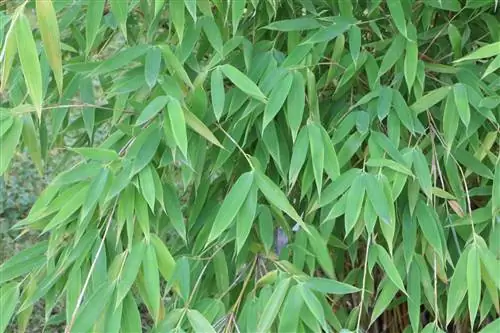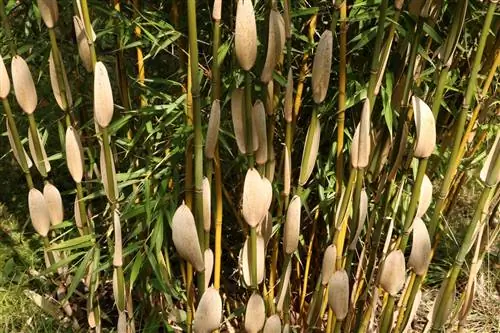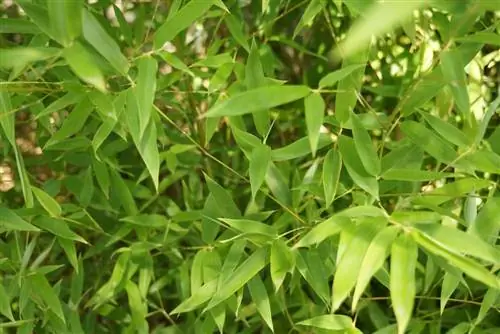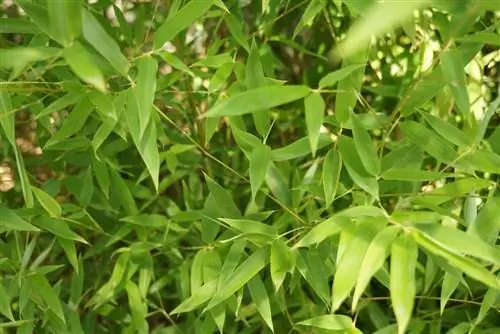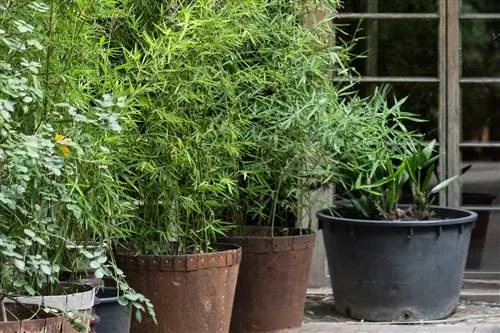- Author admin [email protected].
- Public 2023-12-17 03:39.
- Last modified 2025-01-24 12:45.
Like all types of bamboo, Muriel bamboo is also a sweet grass. This grass, which is native to south-central China, owes its name to the daughter of a British botanist Ernest Wilson. Muriel bamboo reaches heights of between 1 and 5 meters and grows in dense clumps. The stalks of this type of bamboo have a diameter of 0.5 to 1.5 cm. Up to 10 branches form at each node, at the end of which a maximum of 6 elongated, narrow leaves (approx. 6 cm long) grow. There are several known cultivars of this bamboo, e.g. Standing Stone, Flamingo, Green Arrows and others
Special features of Fargesia murielae
Two circumstances make this plant particularly popular with gardeners. The first advantage of Muriel bamboo is that the grass is hardy. This type of bamboo can withstand temperatures down to -28°C. The second important advantage of this bamboo is that it does not form rhizomes and therefore does not proliferate. Many bamboo species annoy garden owners by spreading uncontrollably. This does not happen with the Muriel bamboo, the growth of this plant can be easily controlled by cutting back.
Location and use
Like most grasses, the Muriel bamboo thrives best in sunny locations, although this variety can also tolerate partial shade. The soil must not dry out, otherwise the leaves will turn yellow very quickly and will not recover. Bamboo likes locations protected from the wind, where the plant grows particularly luxuriantly. Because of its tall growth, this bamboo is suitable for use as a hedge plant and also as a privacy screen, for example. B. around the terrace. To do this, the individual clumps can be placed at a distance of approx. 100-150 cm from each other. Muriel bamboo is a beautiful solitary plant that looks very decorative, for example as the visual center of a front garden.
Preparing the soil properly
Although this beautiful bamboo variety is one of the easy-care plants, it still places certain demands on the soil. The plant thrives best in the special bamboo soil. This soil can either be purchased or composed as follows: one third each of garden soil, compost and peat. Pine bark and clay granules can also be added. The granules increase the soil's water retention. The Muriel bamboo generally likes nutrient-rich soil that is not too dry.
Planting plants correctly
Bamboo plants are usually sold in containers. In order to plant the plant correctly, a planting hole must be dug that is about 50 cm deep and approx.40 cm wider than the container should be. The planting hole should be filled approximately 1/3 with the bamboo soil (or with the specially prepared mixture) and 2/3 with the “normal” garden soil. It is important that the bamboo is watered thoroughly immediately; the amount of water can hardly be exaggerated.
Muriel Bamboo Care
Caring for this plant is relatively easy and mainly consists of regular fertilization with bamboo fertilizer. Bamboo professionals believe that the best fertilizer for all types of bamboo is simple horse manure, which should already be composted. In any case, a high-quality bamboo fertilizer should contain nitrogen, phosphorus, potassium and silicon. The fertilizer manufacturer's quantities should be carefully followed because Muriel bamboo reacts sensitively to over-fertilization: its fine leaves turn yellow and fall off. The plant should be fertilized as early as March, at intervals of approx.4 weeks. The plant is also sensitive to waterlogging. The bamboo does not tolerate soils that are too dry.
Cutting and thinning
The optimal time for cutting Muriel bamboo is spring, when the plant begins to sprout. The stalks can be shortened by 1/3. Either a hedge trimmer or garden shears are the right tool. It is best to cut about 1 cm above the respective knot. By cutting, the plants grow denser and bushier, and they generally become more vital. A tip: cut back old, partly yellowed stalks on the inside of the bamboo hedge briefly, then new, lively stalks will develop relatively quickly in this area. For older plants (over 5 years old) it is worth thinning out the stock and removing weaker, shorter stalks. This is good for the plant and keeps it he althy. Limping, the removal of the lower branches on the bamboo, is more of a matter of taste. It can be done on very tall plants. The goal is to provide more light in the garden without removing the bamboo. It also makes a plant look original.
Bamboo as a pot plant
Several varieties of bamboo are ideal as container plants. The winter-hardy Muriel bamboo can be left in a pot all year round, for example on the terrace or in the driveway, but as a potted plant the bamboo requires additional winter protection. Wrapped tightly in the fleece, ideally together with the pot, the bamboo will survive the harsh winter in a place protected from the wind. Otherwise, the usual bamboo care with fertilization and sufficient watering applies to the potted plant, although waterlogging should of course be avoided. The important difference in care compared to garden plants is that the bamboo growing in the pot should be thinned out more often.
Muriel bamboo is a fast-growing, easy-care plant that is not only suitable as a solitary plant, but also as a hedge plant and also as a container plant. Bamboo is hardy, but thrives best in sheltered locations. Planting in the bamboo soil, regular fertilization and watering contribute to the he alth and dense growth of Muriel bamboo.
What you need to know about bamboo
Bamboo Fargesia murielae loves a partially shaded or shady location, but can also cope with sunny places if the humidity is high enough.
Bamboo Fargesia murielae requires some space. The higher the plant grows, the more space the roots require. With a height of 4 meters, around 10 square meters are required. Good garden soil is suitable as soil. It should be fresh and moist. Humus and nutrient-rich soil is ideal.
Since the many leaves evaporate a lot of moisture, you have to water the plant abundantly. It does not tolerate drought. If you water too little, the leaves curl up. Watering must be sufficient even in winter, but only in frost-free weather.
In the first few months after planting in spring or early summer, the bamboo is not fertilized. The plant has to root properly first. Then fertilize once a month with nitrogen-based fertilizer. For older plants, fertilize from April and then until the end of June. The stalks must become woody, otherwise they are not hardy. The plant should now stop growing so that it can survive the winter well. If you mulch the bamboo well, you don't have to water it as much or fertilize it extra.
To protect bamboo Fargesia murielae from drying out and frost in winter, you can sprinkle leaves, straw or mulch between the stalks in early winter.
You can reduce the growth of this bamboo by cutting it.
Bamboo Fargesia murielae is propagated by division in spring. Bamboo can also be propagated by sowing. The sowing soil must not dry out, but it must not be too moist either. Germination takes a few weeks to a few months. The young plants should be overwintered frost-free for the first two or three years. An unheated stairwell or a garage with a window are well suited.
Bamboo Fargesia murielae is also suitable as a container plant. However, you should make sure that it is wintered frost-free.
Bamboo dies after flowering. It rarely blooms, but if you have a bamboo hedge, you have to expect gaps. Almost all of the plants will never bloom, so the hedge is just thinned out.

